Friday, July 21st 2017

Asus X399 ROG Zenith Extreme Unboxed Ahead of Launch
As is usually the case with hardware products these days, it is hard to keep confidential details out of the public eye. With NDAs themselves becoming less rigorous in terms of what is covered and what is not, perhaps it was appropriate that someone over on Chiphell shared some pictures of the upcoming Asus X399 Zenith Extreme motherboard which supports AMD's upcoming Ryzen Threadripper platform. Videocardz were on hand to archive the pictures for everyone in the meantime.
Based on what we know so far, the Asus Zenith Extreme looks to be the only E-ATX form factor motherboard to be revealed in four days time (although MSI is conspicuously absent in that preview), and the pictures we have confirm this. An Asus rep also confirmed that the Zenith Extreme will share an identical power delivery to their X399 Rampage VI Extreme, meaning we finally have a like-for-like treated flagship motherboard on the red side after what seems like ages- especially combined with the announcement of the X370 ROG Crosshair VI Extreme as well.The Zenith Extreme package is loaded with accessories, including a VGA hold bracket if using on an open bench, PCIe Ethernet add-in card (potentially 10 GigE), their DIMM.2 extension card, the usual WiFi antenna, and what appears to be an updated OC Panel with LCD screen. The astute observer will also note a Ryzen Threadripper CPU peeking in one of the images, further indicating this is part of a reviewer press kit.The motherboard adopts the now-standard Asus ROG black and gunmetal grey color scheme with RGB lighting on the board presumably as indicated by the Aura Sync compatibility sticker on the packaging. The TR4 socket continues to be huge and amazing each time I see it. Also note the 8+8 EPS power connectors in the top-right corner of the motherboard and the two-piece, heatpipe-linked VRM heatsink solution, which all points to there being excellent power delivery options to help prevent the CPU and VRM-based throttling some X299 motherboards appear to be suffering from presently.
But time will tell how this works out in practice of course.
There are four full-length PCIe slots which are reinforced to support heavier VGA cards, with the top slot appearing extremely close to the CPU socket and the left bank of DIMM slots, which can be an issue with CPU coolers. The motherboard has eight DIMM slots for DDR4 quad channel memory as well. Aside from the two M.2 slots on the DIMM.2 extension card, there could be a third under the I/O section as well but it could also just be a detailed, discrete audio solution as well. One thing I do see absent is an onboard diagnostic display for error codes which seems a shame to be missing on an E-ATX motherboard.
Source:
Videocardz via Chiphell
Based on what we know so far, the Asus Zenith Extreme looks to be the only E-ATX form factor motherboard to be revealed in four days time (although MSI is conspicuously absent in that preview), and the pictures we have confirm this. An Asus rep also confirmed that the Zenith Extreme will share an identical power delivery to their X399 Rampage VI Extreme, meaning we finally have a like-for-like treated flagship motherboard on the red side after what seems like ages- especially combined with the announcement of the X370 ROG Crosshair VI Extreme as well.The Zenith Extreme package is loaded with accessories, including a VGA hold bracket if using on an open bench, PCIe Ethernet add-in card (potentially 10 GigE), their DIMM.2 extension card, the usual WiFi antenna, and what appears to be an updated OC Panel with LCD screen. The astute observer will also note a Ryzen Threadripper CPU peeking in one of the images, further indicating this is part of a reviewer press kit.The motherboard adopts the now-standard Asus ROG black and gunmetal grey color scheme with RGB lighting on the board presumably as indicated by the Aura Sync compatibility sticker on the packaging. The TR4 socket continues to be huge and amazing each time I see it. Also note the 8+8 EPS power connectors in the top-right corner of the motherboard and the two-piece, heatpipe-linked VRM heatsink solution, which all points to there being excellent power delivery options to help prevent the CPU and VRM-based throttling some X299 motherboards appear to be suffering from presently.
But time will tell how this works out in practice of course.
There are four full-length PCIe slots which are reinforced to support heavier VGA cards, with the top slot appearing extremely close to the CPU socket and the left bank of DIMM slots, which can be an issue with CPU coolers. The motherboard has eight DIMM slots for DDR4 quad channel memory as well. Aside from the two M.2 slots on the DIMM.2 extension card, there could be a third under the I/O section as well but it could also just be a detailed, discrete audio solution as well. One thing I do see absent is an onboard diagnostic display for error codes which seems a shame to be missing on an E-ATX motherboard.
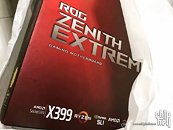
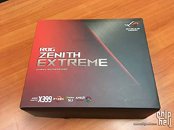
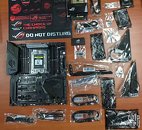
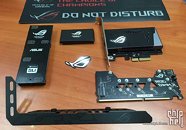
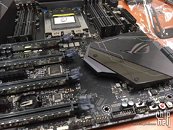
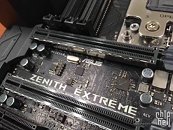
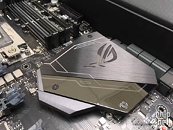
31 Comments on Asus X399 ROG Zenith Extreme Unboxed Ahead of Launch
Wonder what the the tag will be on it
Damn this looks good. Too bad that I don't have any need for a HEDT platform, but still this looks sweet.
Impatiently waiting for more X399 boards.
They replaced the USB 2.0 headers with a USB 3.1 header ;)
It's getting to the point where why should we put USB 2.0 ports on these boards when USB 3.0 is fully backwards compatible with USB 2.0. Any USB 2.0 device will work with USB 3.0 ports so putting USB 2.0 anything on modern boards is simply a waste of space.
At a quick count this board has one USB 2.0 header, two USB 3.1 Gen1 headers, and one USB 3.1 Gen2 header. Four USB headers!! Now I don't know about you but when buying a high end board like this one I'd want it to last as long as it can. What will last longer...more USB 3 headers or more USB 2 headers? When you can simply buy a $10 adaptor that turns a USB 3 header into a USB 2 header then you can potentially have three USB 2 headers right now at ~$20 extra cost (that's if one isn't already included in the huge accessory pack), and at no loss to modern connectors for everyone else.
If ASUS took *away* a USB 3 header to make room for a USB 2 header then sure you wouldn't have to use an adaptor, but what happens to the people that A. did want to use more USB 3 headers straight away or B. will need to use more USB 3 headers in the future? Well they can't if the headers don't exist, and you can't get a USB 2 header to run at USB 3 speeds the same way you can convert a USB 3 header down. You'd have to buy a USB 3 expansion card and start wasting PCIe slots instead.
Sure you could argue that they could have added an extra 2.0 header on top of the other four headers that already exist but then what's the limit here that would please everyone...three USB 2.0 headers? Four? Where do we say no more, just use an adaptor on the preexisting 3.1 headers if you need to!
In some ways I agree, one may indeed be a low number for some people right now, two would have been an ideal maximum in my eyes but I think the small minority that need to use an adaptor or two now is a win for ridding us of older connections going into the future :clap:
I also understand some devices simply don't need the extra bandwidth that USB 3 provides. As far as Aquacomputer stuff goes, if they make products of which you could own several parts that each need to have a USB 2.0 plug to use then why not make a central control box built into say the pump or res that you can hook everything into then it connects to your PC with a single USB 3 header. Now that would be a far more elegant solution than using several USB 2 headers, not to mention make the parts more future proof!
I'm sure ASUS has debate the number of USP headers extensively, but the real test comes when connecting and using a splitter such as @TheLostSwede suggested. Will it cause conflicts or power issues, etc. down the road?
As far as using a splitter, that may cause conflicts down the road. Which is why I've suggested any company producing several products that use 2.0 headers may want to also produce a fully compatible central control box for them all to plug into, then plug that into the board with a single USB 3 header cable. Feed it extra power via a SATA power cable if needed. This will maintain future proofing, provide more power, and use less connectors on the motherboard...that's if they don't already make one which would not surprise me!
Yes, on the motherboard there may be some issues but nothing that an adapter won't fix.